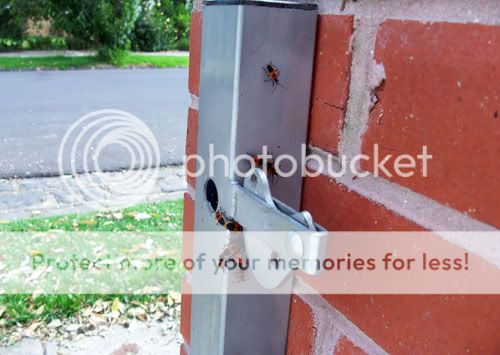It looks like you're using an Ad Blocker.
Please white-list or disable AboveTopSecret.com in your ad-blocking tool.
Thank you.
Some features of ATS will be disabled while you continue to use an ad-blocker.
share:
Nope, these don't eat plants and don't have love hearts on them.
Checkered Beetle
www.whatsthatbug.com...
Either way check this site, they have like 6 pages of beetles to choose from....
www.whatsthatbug.com...
Family Cleridae. Checkered Beetles are brightly patterned with red, orange, yellow and blue and they have bulging eyes. Adults visit flowers and rest on foliage and trunks of dying or dead trees and they prey on the larva of wood boring insects. Larva of some species prey on bark beetle larva while others feed on grasshopper eggs. Our California species, Aulicus terrestris, feeds on caterpillars.
Either way check this site, they have like 6 pages of beetles to choose from....
Heh, I've got a fear of bugs so I couldn't look at much. But from what I saw on the page, none of them are it.
dont know if this will help. i saw these in germany.Pyrrhocoris apterus
www.david.element.ukgateway.net...[/img]
how ever they eat seeds not other insects.
[edit on 1-12-2005 by Enigma27]
www.david.element.ukgateway.net...[/img]
how ever they eat seeds not other insects.
[edit on 1-12-2005 by Enigma27]
Down here in Australia, I see them all the time, especially in summer. We have always called them stink bugs and they often 'mate' buy walking
around joined at the back. Here is some pics of what the look like:



Go here for lots of info



Go here for lots of info
Sounds like some kind of checkered beetle. They feed on other insects, and they also look a bit
like what you're describing.
LOL Okay, this really isn't a joke. You gotta check out this site:
www.whatsthatbug.com...
I figure if you can't find it here...ya can't find it anywhere!
www.whatsthatbug.com...
I figure if you can't find it here...ya can't find it anywhere!

Took this photo yesterday while i was going to a jog. This is taken in a suburb of Melbourne Australia. Pretty sure they are the bugs you are referring to.
It is a recent import from some asian country. I am not sure of the name but description fits. It is a relative of the ladybug if I am not mistaken.
someone will have to look it up.
EDIT: after seeing the posts just above me I think I am talking about the Box Elder bug. Getting confused up here with all the new insects. Fairly recent to S.E. Michigan.
There is also a orange lady bug that is a recent import here in Michigan except they have a nasty little bite... like a horsefly.
Between those and the emerald ash borer, which is really the big problem, it seems we have a lot of new bugs around here.
[edit on 31-1-2006 by pavil]
someone will have to look it up.
EDIT: after seeing the posts just above me I think I am talking about the Box Elder bug. Getting confused up here with all the new insects. Fairly recent to S.E. Michigan.
There is also a orange lady bug that is a recent import here in Michigan except they have a nasty little bite... like a horsefly.
Between those and the emerald ash borer, which is really the big problem, it seems we have a lot of new bugs around here.
[edit on 31-1-2006 by pavil]
Man I know exactly the ones your talking about ive seen them all over in tennessee but I wish I knew what they are called Ive caught a few and showed
them around and noone knew what they are.
Speaking of more bugs we have had a warm winter with less than an inch of snow and no freezing. since the ground hasnt froze at all this summer the bugs will be hellish.
[edit on 1-2-2006 by SoLaR513]
Speaking of more bugs we have had a warm winter with less than an inch of snow and no freezing. since the ground hasnt froze at all this summer the bugs will be hellish.
[edit on 1-2-2006 by SoLaR513]
The bugs were gone for ages so I wasn't able to get a picture, but now they're back and there's heaps of them.


Yep thats like the ones I have seen, like whole swarms of them.
Ya those are the box-elders, as a kid i used to squish them cause it would make quite the mess!! (of course I don't do this anymore...)
According to Wikipedia, they feed on leafs. The ones here feed on dead bugs.
Nventual,
Lucky for you, I am an expert in entomology/insects.
The bug in question is indeed a bug (as opposed to beetles, flies, grasshoppers, cockroaches, wasps, moths, etc.). And specifically in the order Hemiptera (bugs comprise of 2 orders, Hemiptera and Homoptera). Unfortunately, Hemiptera comprise of THOUSANDS and THOUSANDS of species and families. However, I can tell from the photo that we're dealing with a member of the suborder Gymnacerata (long-horned bugs), which consists of other families that include the boxelder and milkweed bug. However, to get a more precise ID, it will require a closeup shot so that I can see how many antennae segments there are and how many veins in the forewings. IDing Gymnaceratans can be very tricky.
For a sec, I thought these may be some kind of assassin bug due to the elongated edges of the abdomen common among assassin bugs, but these are also common among leaf-footed bugs. Elongated edges of the abdomen, again, are no smoking gun though. Also, assassin bugs are strictly predatory (as opposed to feeding on plants or scavengers of the dead), and they typically do not congregate like that. Congregation, however, is common among the plant-sucking members of Gymnacerata. Also common is them scavenging on the dead, although that is NOT their primary source of food. They may also turn to the dead if their primary food source is depleted.
These are DEFINITELY not beetles, and I knew right away these can't be from the first few posts. How? Beetle adults looks DRASTICALLY different from their young. The young are called larvae and are typically wormlike. Looks totally totally different. Bug young, however, are called nymphs and are basically just miniature versions of the adult but without wings and frequently with different coloration patterning.
Lucky for you, I am an expert in entomology/insects.
The bug in question is indeed a bug (as opposed to beetles, flies, grasshoppers, cockroaches, wasps, moths, etc.). And specifically in the order Hemiptera (bugs comprise of 2 orders, Hemiptera and Homoptera). Unfortunately, Hemiptera comprise of THOUSANDS and THOUSANDS of species and families. However, I can tell from the photo that we're dealing with a member of the suborder Gymnacerata (long-horned bugs), which consists of other families that include the boxelder and milkweed bug. However, to get a more precise ID, it will require a closeup shot so that I can see how many antennae segments there are and how many veins in the forewings. IDing Gymnaceratans can be very tricky.
For a sec, I thought these may be some kind of assassin bug due to the elongated edges of the abdomen common among assassin bugs, but these are also common among leaf-footed bugs. Elongated edges of the abdomen, again, are no smoking gun though. Also, assassin bugs are strictly predatory (as opposed to feeding on plants or scavengers of the dead), and they typically do not congregate like that. Congregation, however, is common among the plant-sucking members of Gymnacerata. Also common is them scavenging on the dead, although that is NOT their primary source of food. They may also turn to the dead if their primary food source is depleted.
These are DEFINITELY not beetles, and I knew right away these can't be from the first few posts. How? Beetle adults looks DRASTICALLY different from their young. The young are called larvae and are typically wormlike. Looks totally totally different. Bug young, however, are called nymphs and are basically just miniature versions of the adult but without wings and frequently with different coloration patterning.
new topics
-
Simple Thanksgiving
Food and Cooking: 1 hours ago -
Trump could make a peaceful American Revolution
US Political Madness: 4 hours ago -
Trump Presidential Transition Team will not use GSA or Government entities to come to DC
US Political Madness: 5 hours ago -
Mind Blowing Cave under someones land
Fragile Earth: 5 hours ago -
The Party of Peace - Trump Cabinet Picks Targeted with Death Threats
US Political Madness: 6 hours ago -
V.P. Kamala Harris releases a video and nobody understands why
US Political Madness: 9 hours ago
top topics
-
D.B. Cooper mystery may be solved
General Conspiracies: 14 hours ago, 21 flags -
V.P. Kamala Harris releases a video and nobody understands why
US Political Madness: 9 hours ago, 16 flags -
The Party of Peace - Trump Cabinet Picks Targeted with Death Threats
US Political Madness: 6 hours ago, 14 flags -
Mind Blowing Cave under someones land
Fragile Earth: 5 hours ago, 12 flags -
Trump Presidential Transition Team will not use GSA or Government entities to come to DC
US Political Madness: 5 hours ago, 12 flags -
Trump could make a peaceful American Revolution
US Political Madness: 4 hours ago, 12 flags -
Simple Thanksgiving
Food and Cooking: 1 hours ago, 4 flags
active topics
-
V.P. Kamala Harris releases a video and nobody understands why
US Political Madness • 63 • : WeMustCare -
I thought Trump was the existential threat?
World War Three • 106 • : lilzazz -
The Party of Peace - Trump Cabinet Picks Targeted with Death Threats
US Political Madness • 9 • : DBCowboy -
Simple Thanksgiving
Food and Cooking • 7 • : DontTreadOnMe -
Trump Presidential Transition Team will not use GSA or Government entities to come to DC
US Political Madness • 9 • : matafuchs -
Post A Funny (T&C Friendly) Pic Part IV: The LOL awakens!
General Chit Chat • 7838 • : GENERAL EYES -
The Acronym Game .. Pt.4
General Chit Chat • 995 • : JJproductions -
Trump could make a peaceful American Revolution
US Political Madness • 8 • : Flyingclaydisk -
Mind Blowing Cave under someones land
Fragile Earth • 14 • : Flyingclaydisk -
President-Elect DONALD TRUMP's 2nd-Term Administration Takes Shape.
Political Ideology • 254 • : WeMustCare




